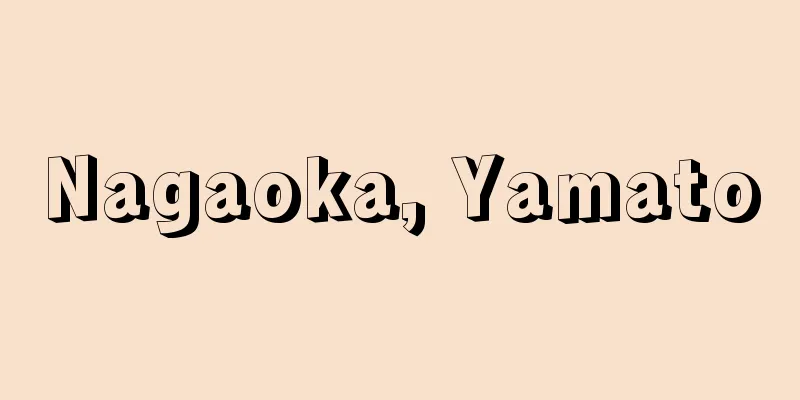Raigou

|
〘Noun〙 (formerly known as "raiko")① (━suru) Buddhist term. When a devotee of Nembutsu is about to die, Amida Buddha and other bodhisattvas come to welcome him or her and take him or her to the Pure Land. In Shinshu, this refers to the Buddha waiting to welcome the devotee when he or she returns to the Pure Land, according to Amida Buddha's original vow. The coming of the Buddha. → Raigoinjo (Raigoinjo). ※Edotoku Nagonganmonshu (Post-Heian period) 2. Dojo Omichiko's reverse prayer text "After a thousand years, I will wait for the coming of Kannon ."② The sunrise seen from the top of a high mountain. The coming of light. The coming of the Buddha. *Haiku poem, Sakuragawa (1674), Natsu 2, "Raigo ya mimare mizumare Fujimaude (Mannenko)" ③ A phenomenon in which, when standing with the sun at your back at sunrise or sunset on the top of a high mountain, your shadow is projected onto the mist or clouds in front of you, creating a ring of colored light around it. It is said to be likened to a Buddha or bodhisattva coming to greet you wearing a halo . Brocken phenomenon. Raiko. Go-raigo. ④ Welcoming the moonrise on the 26th night of waiting. Go-raigo. ⑤ A toy. A small Buddha statue made of paper is placed inside a tube, and when the tube is lowered, the folded paper halo opens and the Buddha statue pops out. Go-raigo. [Etymology] (1) In the Setsuyoshu and "Nippo Jisho", it is called raikau, and it is thought that it became voiced as raigau in the early modern period or later. (2) The manner in which one should pray for the coming of Amida Buddha to welcome oneself at the moment of death is described in the “Rinju Gyogi” section of the “Ojoyoshu – Daibunroku,” and the manner in which it should be done is described in various tales of the dead from the Middle Ages onwards and in the “Konjaku Monogatarishu,” among others. (3) The scene at the time of the Raigo ceremony is depicted in a fairly standardized form, such as, "Purple clouds drifted in the west, the room was filled with strange fragrance, and music filled the air" ( Heike - Kanjo). Source: The Selected Edition of the Japanese Language Dictionary About the Selected Edition of the Japanese Language Dictionary Information |
|
〘名〙 (古くは「らいこう」)① (━する) 仏語。念仏行者の臨終に、阿彌陀仏や諸菩薩が迎えに来て浄土に連れて行くこと。真宗では、阿彌陀仏の本願によって、念仏者が浄土に帰って来るのを仏が待ち迎えることをいう。御来迎。→来迎引接(らいごういんじょう)。※江都督納言願文集(平安後)二・道女御道子逆修願文「千秋尽而露命墜剋待二観音之来迎一」② 高山の頂上で見る日の出。来光。御来迎。※俳諧・桜川(1674)夏二「来迎や見まれ見ずまれふじまうで〈万年子〉」③ 高山の頂上などで、日の出・日没時に、陽光を背にして立つと自分の影が前面の霧や雲に投影され、その周囲に色のついた光の輪ができる現象。仏・菩薩が光背(こうはい)を負って来迎する姿に見立てていう。ブロッケン現象。来光。御来迎。④ 二十六夜待(にじゅうろくやまち)の月の出を迎えること。御来迎。⑤ 玩具の一つ。筒の中に紙などで作った小さな仏像を入れ、筒をさげると紙を畳んだ光背が開いて仏像がせり出してくるもの。御来迎。[語誌](1)節用集や「日葡辞書」等ではライカウであり、ライガウと濁音化したのは近世以降と考えられている。 (2)臨終の際に阿彌陀仏来迎を願う場合の作法については、「往生要集‐大文六」の「臨終行儀」に記され、そのさまは中古以来の諸往生伝や「今昔物語集」などに描かれている。 (3)来迎の際の様子は、「西に紫雲たなびき、異香(いきゃう)室にみち、音楽そらにきこゆ」〔平家‐灌頂〕のようなかたちで、ほぼ定型化して表現される。 出典 精選版 日本国語大辞典精選版 日本国語大辞典について 情報 |
Recommend
Bedlington terrier
A domestic dog originating from England. Its name ...
Asamamono - Asamamono
A classification term for Japanese music. A type o...
Ethnic Movies
…Jean-Luc Godard said, "All films are Americ...
Francis Ronalds
1788‐1873 British telegraph and meteorological eng...
Bonding Initiation - Kechien Kanjo
〘Noun〙 Buddhist term. An initiation ceremony given...
Amal Shataka
…Years of birth and death unknown. Author of the ...
Honmyogawa River
A river in eastern Nagasaki Prefecture. It origina...
Gigantomachia
…Using rocks and tree stumps as weapons, they cha...
Mirza Taqi Khan
?-1852 A reformist politician of the mid-Qajar dyn...
Avalon (English spelling)
A town on Santa Catalina Island in the Channel Isl...
gopiyantra (English spelling)
…A plucked drum is basically the same as a fricti...
Kali-yuga (English spelling)
...In Hindu cosmology, as seen in the Puranas, th...
Kura (English spelling)
A major river in the Transcaucasus region. It is 1...
The theory of entrapment
...An investigative method in which an investigat...
Haiga - Haiga
A painting with a taste for haiku. It praises hai...







![Rustica (English spelling) [Italy]](/upload/images/67cd30734cd77.webp)

